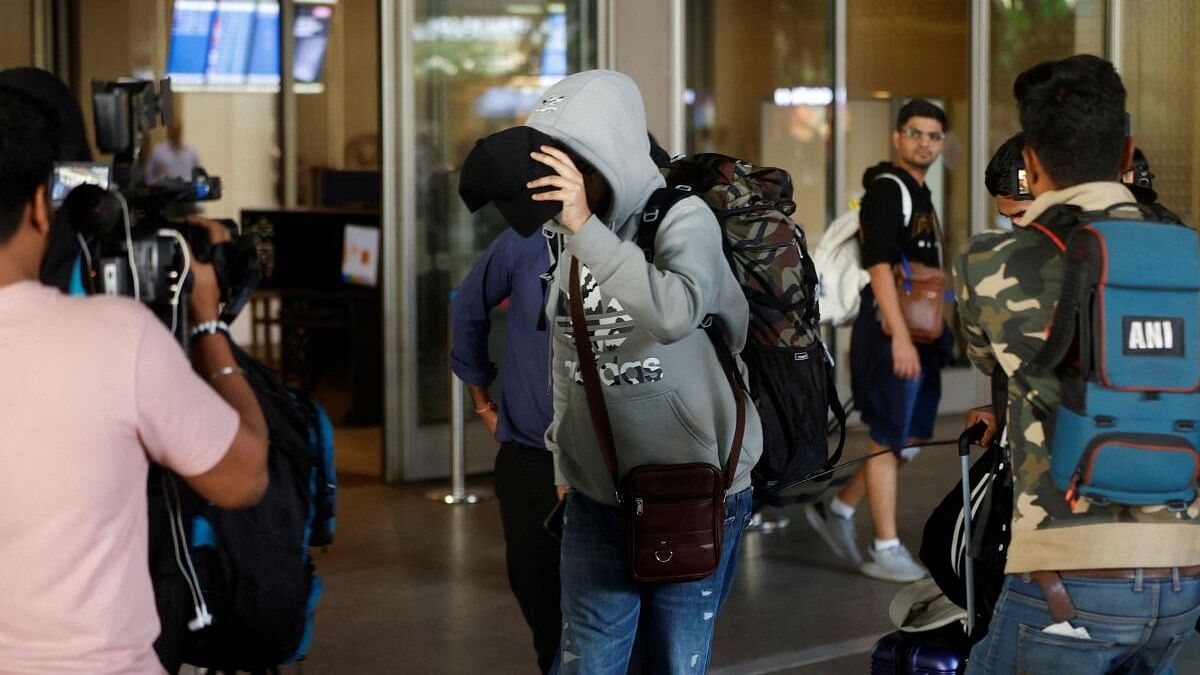
A passenger from Nicaragua bound Airbus A340 flight that was grounded in France on suspicion of human trafficking, evades the media as he leaves the Chhatrapati Shivaji Maharaj International Airport after his arrival, in Mumbai, India, December 26, 2023.
Credit: Reuters Photo
In the ever-evolving tapestry of global migration, an unsettling trend has emerged, weaving India intricately into the narrative of illegal immigration through Nicaragua's colloquially termed 'donkey route.' The Central American nation, renowned for its real estate allure and tourist attractions, is increasingly serving as a launching pad for illegal migrants, a significant number of whom are Indians, endeavouring to reach the United States and Canada.
Nicaragua's appeal as a migrant gateway stems from its porous borders and lenient visa policies. Facilitated by agents, it has become a pivotal point for those attempting to traverse the hazardous Darien Gap jungle—a perilous route for migrants from South American and Caribbean countries, Africa, and Asia en route to the United States.
Amid these challenges, the Nicaraguan government, led by President Daniel Ortega, stands accused of intentionally smoothing the path for migrants. Ortega, a historical adversary of the United States, appears to have strategically enabled migrants to bypass the formidable Darien Gap by flying directly to Nicaragua before embarking on an overland journey northward.
Manuel Orozco, a migration expert at the Inter-American Dialogue in Washington, suggests that Nicaragua's government is actively supporting "the business of a network of international air services," expediting migrants' journeys toward the United States.
The recent grounding of an Airbus A340 in Paris, carrying 303 Indian migrants en route to Nicaragua, sheds light on the scale of this clandestine operation. Though passengers were later determined to be traveling voluntarily, the incident underscores the significant sums paid by Indian migrants to agents facilitating their journey to the southern border of the United States.
Honduras' migration statistics reveal a noteworthy five-fold increase in arrivals from countries such as Guinea, China, Senegal, India, Afghanistan, and Angola, with migrants crossing into the country from Nicaragua. Nicaragua has evolved into a "springboard" for Cubans, Indians, Asians, and Haitians, taking advantage of relaxed visa requirements since 2021.
Ambiguity in Visa Rules
The ambiguity surrounding visa rules for Indians further complicates matters. While an agreement exists between the Indian and Nicaraguan governments allowing Indian passport holders to enter without a visa, reports suggest that the Nicaraguan embassy does not issue tourist visas. This ambiguity, coupled with the porous border, has inadvertently made Nicaragua an attractive haven for illegal immigration.
Nicaragua has emerged as a migratory springboard, leveraging relaxed entry requirements to attract Indians and other foreign nationals. An Associated Press report reveals hundreds of charter flights, believed to carry migrants primarily from various countries, landing in Nicaragua in 2023. Experts suggest that the Nicaraguan government is using migration as a foreign policy tool, a sentiment echoed in reports detailing a "shadow industry" of charter flights moving 'donkey travellers' across the Americas.
The presence of Indians in this intricate web of illegal migration is striking. According to the US Customs and Border Patrol (CBP), a staggering 96,917 Indians were arrested attempting to enter the US illegally in 2023 alone. This places Indians as the third-largest illegal immigrant community in the US, totalling around 725,000. Many of them opt for unconventional routes—Nicaragua among others—barefoot and determined, with 30,010 arrests at the Canadian border and 41,770 at the southern border.
As Nicaragua becomes a focal point for Indian migrants on the 'donkey route,' a nuanced understanding of this intricate web of migration is essential. Addressing the root causes, clarifying visa regulations, and fostering international cooperation are crucial steps to untangle this complex issue.
India, along with other nations caught in the crosshairs of this unconventional migration route, faces the challenge of safeguarding its citizens while navigating the complex dynamics of global migration trends. The multifaceted dilemma of balancing real estate appeal with the need to address migration challenges poses significant questions for Nicaragua and the nations entangled in this intricate migration landscape. In the pursuit of solutions, collaboration, and proactive measures become imperative to ensure the integrity of immigration systems and protect the well-being of those seeking a better life through unconventional routes.